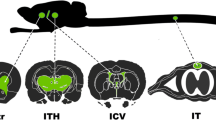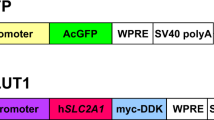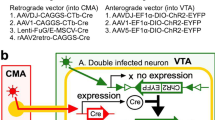Abstract
In vivo gene transfer of glutamate decarboxylase (GAD) has been explored as a means of inducing or increasing the production of the inhibitory amino-acid neurotransmitter, GABA. This strategy has been applied to neuroprotection, seizure prevention, and neuromodulation. In the present experiment, AAV2 was used to transfer the genes for green fluorescence protein (GFP) and GAD65 into the lateral nucleus of the rat hypothalamus. Microinjection of 500 nl of AAV2 resulted in transduction of a 0.25±0.04 mm3 with targeting errors of X=0.48 mm, Y=0.18 mm, Z=0.37 mm using standard stereotactic technique. Pre- and postinjection food and water consumption, urine and feces production, and weight were recorded. In comparison with rAAVCAGGFP- and PBS-injected animals, rats treated with rAAVCAGGAD65 demonstrated reduced weight gain (P<0.014) and transiently reduced daily food consumption (P<0.007) during the postoperative period. No changes in water consumption or waste production were recorded. Effective GAD65 gene transfer was confirmed with in situ hybridization using a probe to the woodchuck post-transcriptional regulatory element sequence included in the vector. These findings suggest that increased GABA production in lateral nucleus of the hypothalamus induced by GAD65 gene transfer may reduce weight gain through reduced feeding.
This is a preview of subscription content, access via your institution
Access options
Subscribe to this journal
Receive 12 print issues and online access
$259.00 per year
only $21.58 per issue
Buy this article
- Purchase on Springer Link
- Instant access to full article PDF
Prices may be subject to local taxes which are calculated during checkout





Similar content being viewed by others
References
Wilson S et al. Antihyperalgesic effects of infection with a preproenkephalin-encoding herpes virus. Proc Natl Acad Sci USA 1999; 96: 3211–3216.
Yoshimura N et al. Gene therapy of bladder pain with herpes simplex virus (HSV) vectors expressing preproenkephalin (PPE). Urology 2001; 57 (Suppl 1): 116.
Muramatsu S et al. Behavioral recovery in a primate model of Parkinson's disease by triple transduction of striatal cells with adeno-associated viral vectors expressing dopamine-synthesizing enzymes. Hum Gene Ther 2002; 13: 345–354.
During M et al. In vivo expression of therapeutic human genes for dopamine production in the caudates of MPTP-treated monkeys using an AAV vector. Gene Therapy 1998; 5: 820–827.
Sacchettoni S et al. Glutamate-modulated production of GABA in immortalized astrocytes transduced by a glutamic acid decarboxylase-expressing retrovirus. GLIA 1998; 22: 86–93.
Robert J et al. Adenovirus-mediated transfer of a functional GAD gene into nerve cells: potential for the treatment of neurological disease. Gene Therapy 1997; 4: 1237–1245.
Mi J et al. Recombinant adeno-associated virus (AAV) drives constitutive production of glutamate decarboxylase in neural cell lines. J Neurosci Res 1999; 57: 137–148.
During M et al. Subthalamic GAD gene transfer in Parkinson disease patients who are candidates for deep brain stimulation. Hum Gene Ther 2001; 12: 1589–1591.
Luo J et al. Subthalamic GAD gene therapy in a Parkinson's disease rat model. Science 2002; 298: 425–429.
Anand B, Brobeck J . Hypothalamic control of food intake in rats and cats. Yale J Biol Med 1951; 24: 123–140.
Devor M et al. Physiological control of hypothalamically elicited feeding and drinking. J Comp Physiol Psychol 1970; 73: 226–232.
Valenstein E, Myslobodsky M . An inability of gamma-acetylenic GABA to block eating evoked by hypothalamic stimulation. Behav Brain Res 1980; 4: 343–349.
Kimura H, Kuriyama K . Distribution of gamma-aminobutyric acid (GABA) in the rat hypothalamus: functional correlates of GABA with activities of appetite controlling mechanisms. J Neurochem 1975; 24: 903–907.
Kelly J et al. GABA stimulation and blockade in the hypothalamus and midbrain: effects on feeding and locomotor activity. Pharmacol Biochem Behav 1977; 7: 537–541.
Rattan A, Mangat H . Electrical activity and feeding correlates of intracranial hypothalamic injection of GABA, muscimol and picrotoxin in the rats. Acta Neurobio Exp 1990; 50: 23–36.
Paxinos G, Watson C . Rat Brain in Stereotaxic Coordinates, 4th edn. Academic Press: New York, 1998.
Davidson B et al. Recombinant adeno-associated virus type 2, 4, 5 vectors: transduction of variant cell types and regions in the mammalian central nervous system. Proc Natl Acad Sci USA 2000; 97: 3428–3432.
Chamberlin N et al. Recombinant adeno-associated virus vector: use for transgene expression and anterograde tract tracing in the CNS. Brain Res 1998; 793: 169–175.
Peel A, Klein R . Adeno-associated virus vectors activity and applications in the CNS. J Neurosci Methods 2000; 98: 95–104.
Summerford C, Samulski R . Membrane-associated heparan sulfate proteoglycan is a receptor for adeno-associated virus type 2 virions. J Virol 1998; 72: 1438–1445.
Boulis N et al. Adeno-associated viral gene expression in the adult rat spinal cord following remote vector delivery. Mol Ther 2000; 1: S110–S111.
Kaspar B et al. Targeted retrograde gene delivery for neuronal protection. Mol Ther 2002; 5: 50–56.
Klein R et al. Dose and promoter effects of adeno-associated viral vector for green fluorescent protein expression in the rat brain. Exp Neurol 2002; 176: 66–74.
Bankiewicz K et al. Convection-enhanced delivery of AAV vector in parkinsonian monkeys: in vivo detection of gene expression ad restoration of dopaminergic function using pro-drug approach. Exp Neurol 2000; 164: 2–14.
Sanchez-Pernaute R et al. Functional effect of adeno-associated virus mediated gene transfer of aromatic L-amino acid decarboxylase into the striatum of 6-OHDA-lesioned rats. Mol Ther 2001; 4: 324–330.
Bartlett J, Samulski R, McCown T . Selective and rapid uptake of adeno-associated virus type 2 in brain. Hum Gene Ther 1998; 9: 1181–1186.
McCown T et al. Differential and persistent expression patterns of CNS gene transfer by an adeno-associated virus (AAV) vector. Brain Res 1996; 713: 99–107.
Tenenbaum L et al. Tropism of AAV-2 vectors for neurons of the globus pallidus. Neuro Rep 2000; 11: 2277–2283.
Xu R et al. Quantitative comparison of expression with adeno-associated virus (AAV-2) brain-specific gene cassettes. Gene Therapy 2001; 8: 1323–1332.
Buckholtz NS et al. Lysergic acid diethylamide (LSD) administration selectively downregulates serotonin2 receptors in rat brain. Neuropsychopharmacology 1990; 3: 137–148.
Harrison L, Kastin A, Zadina J . Opiate tolerance and dependence: receptors, G-proteins, and antiopiates. Peptides 1998; 19: 1603–1630.
Gupta RC, Patterson GT, Dettbarn WD . Mechanisms of toxicity and tolerance to diisopropylphosphorofluoridate at the neuromuscular junction of the rat. Toxicol Appl Pharmacol 1986; 84: 541–550.
Barnes E . Use-dependent regulation of GABAA receptors. Int Rev Neurobiol 1996; 39: 53–76.
Grimm D et al. Novel tools for production and purification of recombinant adenoassociated virus vectors. Hum Gene Ther 1998; 9: 2745–2760.
Clark K et al. Highly purified recombinant adeno-associated virus vectors are biologically active and free of detactable helper and wild-type viruses. Hum Gene Ther 1999; 10: 1031–1039.
Acknowledgements
The present work was supported by NIH Grants GM 34902, HL64762, T32 NS07222, NS 36778, NS 38849, NS 43305.
Author information
Authors and Affiliations
Rights and permissions
About this article
Cite this article
Noordmans, A., Song, D., Noordmans, C. et al. Adeno-associated viral glutamate decarboxylase expression in the lateral nucleus of the rat hypothalamus reduces feeding behavior. Gene Ther 11, 797–804 (2004). https://doi.org/10.1038/sj.gt.3302223
Received:
Accepted:
Published:
Issue Date:
DOI: https://doi.org/10.1038/sj.gt.3302223



